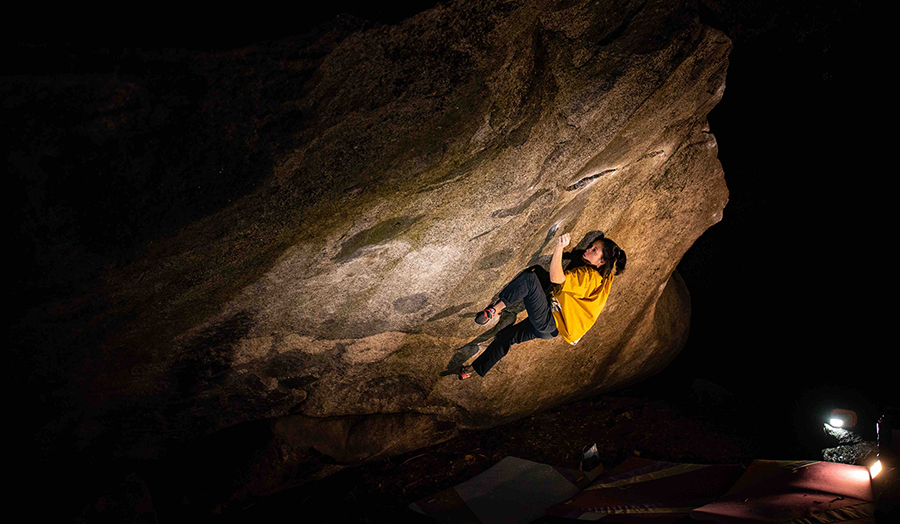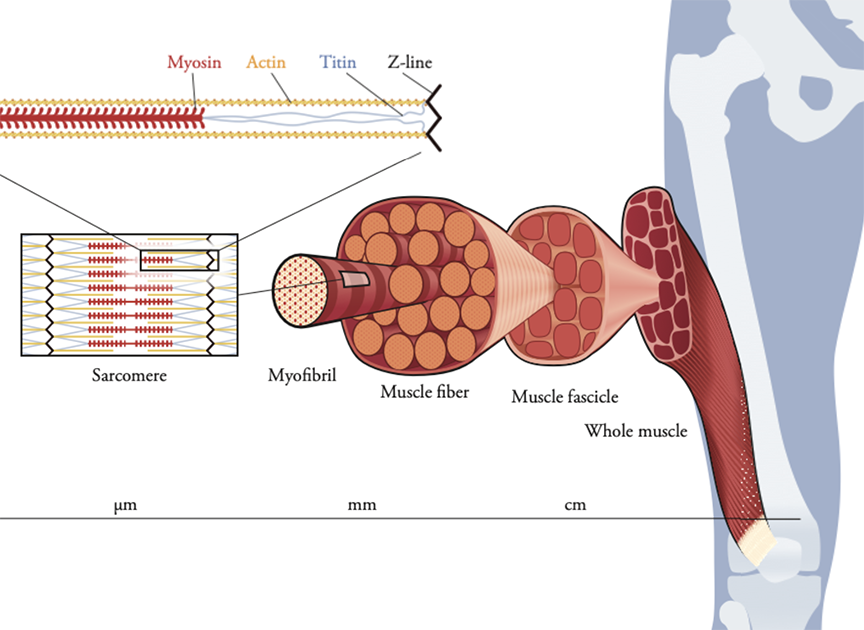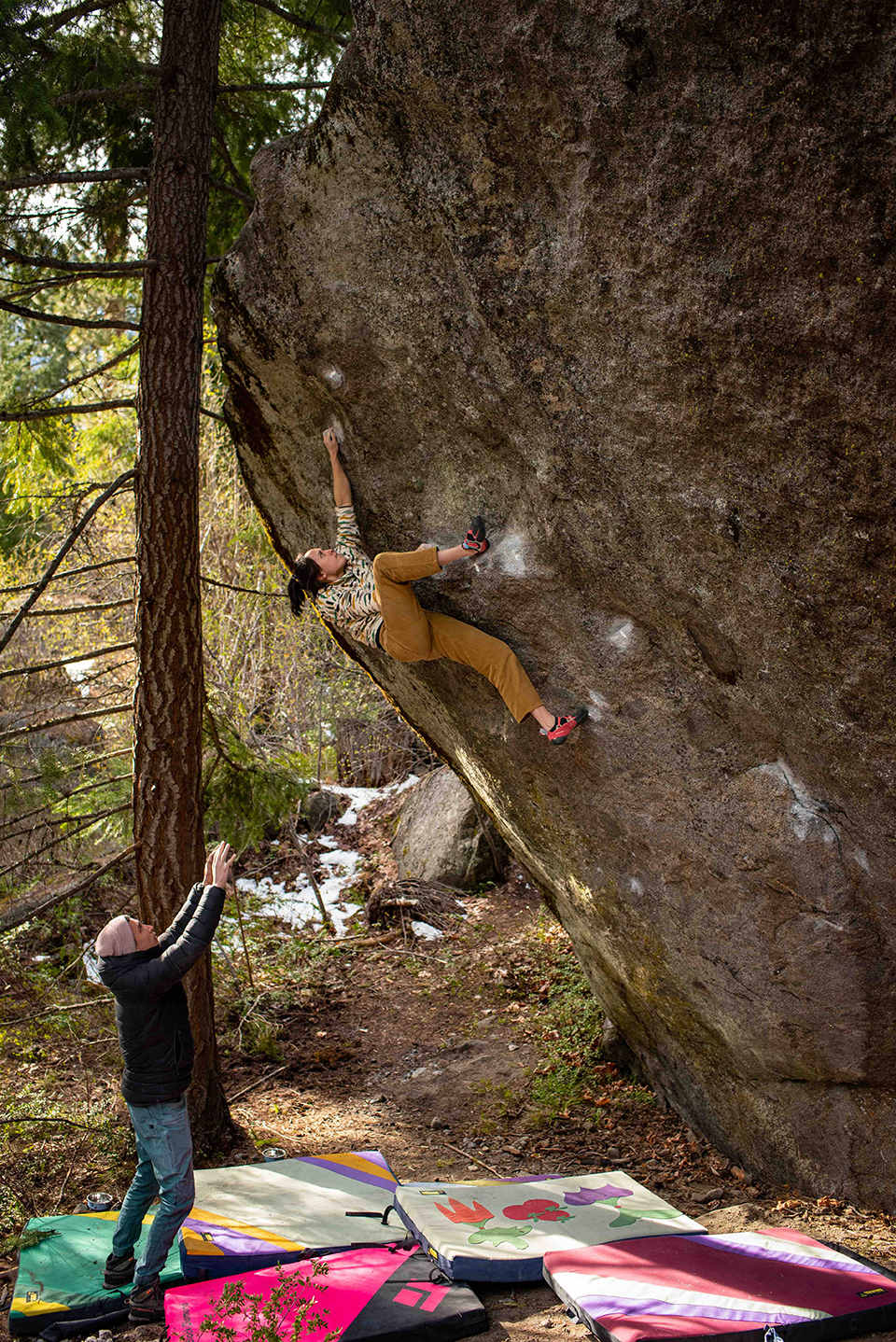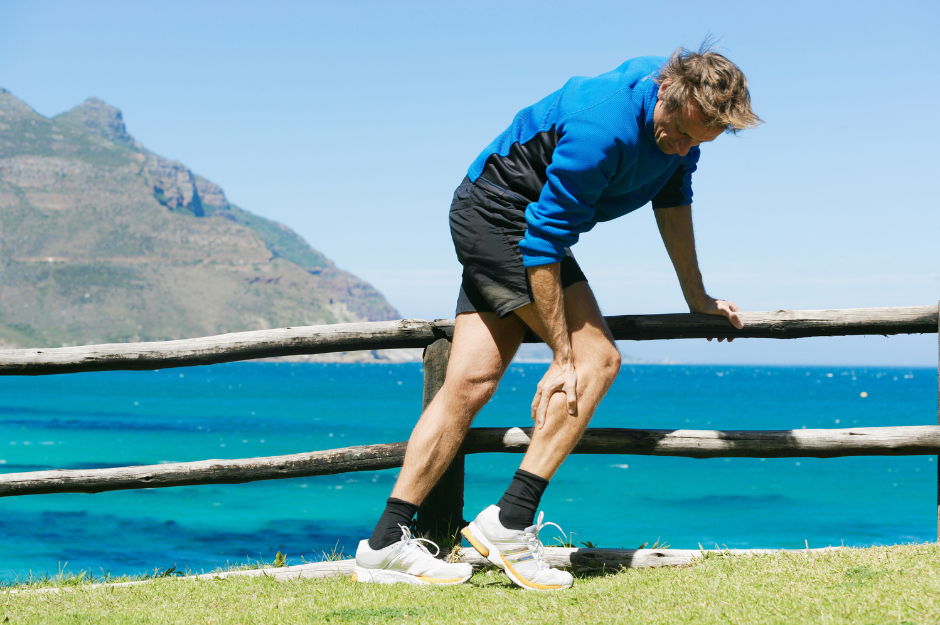

How To Optimize Muscle Recruitment and Strength
Can you have big strength without big muscles? What exactly makes one person stronger than another? Can you train your nervous system?
October 17, 2023

Scott Delp, PhD
Dr. Scott Delp is the James H. Clark Professor of Bioengineering, Mechanical Engineering, and Orthopaedic Surgery. Director of the Wu Tsai Human Performance Alliance at Stanford. Co-author of Biomechanics of Movement: The Science of Sports, Robotics, and Rehabilitation.

Katie Lamb
Katie Lamb is a climber and Patagonia Climb Ambassador, who works part-time as a data engineer. She is the first woman to climb V16. She graduated from Stanford University with a masters in environmental engineering and a bachelors in computer science. Follow her adventures on Instagram at @ktlambies.
Katie Lamb is undoubtedly strong. She is a climber who has ticked off boulders like Box Therapy (V16) in Rocky Mountain National Park, Colorado, Direct North (V14) in Bishop, California, and New Baseline (V14) in Magic Wood, Switzerland.
For those who are not climbers, those are tough boulder problems (V0 is the easiest grade and V17 is the max with only a handful of men in the world climbing at that level). Only 13 other women have climbed V14 or higher. According to Climbing Magazine, Lamb has “racked up one of the most impressive bouldering ticklists of all time” and is “among America’s most accomplished pebble wrestlers”1 – a wonderfully quirky way to praise her accomplishments in the sport.
Lamb grew up in Lexington, Massachusetts, and started climbing when she was 8 years old, encouraged by her climber parents and brother. “I didn’t have the attention span until I was eight,” she said, taking our call from a coffee shop in Berkeley, California. Lamb climbed local crags in New England and ascended the competitive ranks, eventually joining Stanford University’s climbing team and becoming the top Stanford woman at nationals. She is now an Ambassador for Patagonia Climb.
Something you may notice about Lamb is that she is small at 5 feet 5 inches, but she is also mighty. In climbing, the key is to optimize your strength to body mass ratio; building large muscles also means more mass to lift during a climb. “What climbers need is to get everything they can out of a small muscle, train to build up fatigue resistance, and perfect coordination,” said Dr. Scott Delp.
While most of us envision big muscles when we think of strength, that’s only part of the story. The science behind strength is much more nuanced than the size of a bicep – and climbers are often a great example of this. Let’s see why.
Mind Over Muscle: How Your Nervous System Improves Muscle Gains
First, let’s define what we mean by muscle strength. Simply put, muscle strength is the ability of a muscle to produce force against resistance. But as with many things in life, the reality is much more complex. Muscle strength is an intricate balance between several factors, including the size of our muscle and the type of muscle fibers we possess — you may have heard of “fast-twitch” and “slow-twitch” muscles.

Image: Katie Lamb climbing Dominator (V12) in Yosemite Valley, California. Credit: Keenan Takahashi.
One of the other key players in muscle strength is the nervous system (the brain, spinal cord, and network of nerves throughout the body). Your muscles can’t produce force without the proper signals from your brain. Does this mean “training” your nervous system can change your strength? Yes – and climbers must train their nervous system every time they are confronted with a demanding new route.
Each of our body’s approximately 600 muscles is composed of a set of muscle cells or “fibers.” Think of the nervous system as the conductor of an orchestra, and each muscle fiber as an individual musician. When the conductor signals for a certain movement, the musicians work together to produce a harmonious performance. Similarly, when the nervous system signals the muscles to contract, individual muscle fibers respond by contracting in a coordinated manner.

Human skeletal muscle is composed of bundles of muscle fascicles, which are bundles of muscle fibers or muscle cells. These muscle cells can be further broken down into cellular machinery called myofibrils. David Delp | Biomechanics of Movement
Each of these muscle fibers are built from contractile elements called sarcomeres. As you pack more sarcomeres next to one another, or in parallel, your muscle gets bigger and wider. The more sarcomeres you have in parallel, the more force you can generate.
“If you have just one muscle and your nervous system is really good at exciting it, then you can excite the whole muscle and generate its maximum force,” said Dr. Delp. “If you’re untrained, however, you can’t excite all of the contractile machinery to generate force, maybe only 70 or 80%. When you train, however, you learn to excite a bigger fraction of your contractile tissue.”
Some athletes like climbers have the capacity to generate high forces but don’t have big muscles. That’s in part because they can excite all of the contractile tissue. They get the most out of every single muscle. Even though their muscles might not be big, the force they are generating is high.
Research has shown that when starting a resistance training program, your ability to activate a muscle increases.2,3 This allows for more muscle fibers to be recruited and a greater force to be produced, even before the muscle increases in size. This also means that during the first couple of weeks, you may see big gains at first that then slow down.4,5 Don’t be discouraged if this happens. The big early gains are due in part to neural system retraining, which happens fairly quickly. It will take longer to increase your muscle mass.

Training Tip
Don’t worry if you see big gains within the first few of weeks of a training program and then the rate of gain tapers off. The development of muscle mass tends to follow a more consistent, gradual pattern of development compared to nervous system training.5
Lamb trains her nervous system in her practices too. If she’s struggling on a tough boulder problem, she breaks the moves into pieces and trains each movement individually. In some cases, she even trains holding the position on the wall itself.
“There are certain times where I just hold positions,” said Lamb. “So if there is a move where I’m going left hand up and it’s like a big move, then I’ll start with my left hand up and my right hand down. I’ll just hold that position and try to build up a specific muscle activation.”

Image: Katie Lamb climbing The Penrose Step (V14) in Leavenworth, WA. Credit: Keenan Takahashi.
If that’s too difficult, she will have someone put a hand on her back and help push her through the move. This takes some of the weight off as she gets the nervous system training squared away. Sometimes this can result in achieving moves that “felt impossible” just a week ago.

Climbing Tip
Break the problem into pieces. Try to master the individual moves before putting all the pieces into one climb. If needed, ask someone to place a hand on your back to take the weight off as you get used to the new movement.
Antagonist Muscles: How Coordination Affects Functional Strength
When you train your muscles, for example by lifting weights or climbing, not only are you training your nervous system to excite muscles completely, but you are learning to not excite antagonistic muscles – those that oppose the muscle you’re trying to excite. When you are new to a task, you are not necessarily well coordinated. You may excite muscles that help you, but you may also excite muscles that are antagonistic, or unhelpful, to that movement.
In the case of poor coordination, the muscles may be producing high forces but working against one another, which may reduce the force generated at the contact with a bolder or apparatus. The net result is reduced functional strength.
“When you practice a task, your nervous system is getting organized to excite a set of muscles in an optimal pattern to execute that task and pruning away activity in antagonistic muscles,” said Dr. Delp. “People often think about training as only building big muscles, but training also teaches your nervous system. And while some people call it muscle memory, it’s really memory in your nervous system about how to coordinate a set of muscle activities well.”
What About Rest and Recovery?
Other factors such as fatigue can impact our muscle strength. When we are fatigued, our nervous system may not be able to activate as many neurons that excite muscle, leading to decreased muscle force.
Lamb trains for two days in a row, takes a rest day, and repeats. Only one of those two days is intense climbing. Her second day is lifting and some low-intensity climbing. She also works muscles like pectorals (chest muscles) and triceps, which she doesn’t engage as frequently during her climbing sessions. Other exercises she performs include bicep curls, weighted pull-ups, finger-specific training, and movements that work her big muscle groups. On the third day she rests.
For recovery, Lamb makes sure to include days off from climbing in her routine to avoid overuse injuries. “What she is doing is allowing time for a regenerative response to avoid injury and allow for the genesis of new sarcomeres,” said Dr. Delp.
Did You Know?
Contrary to popular belief, there is no muscle tissue within the fingers except for the adductor pollicis and abductor pollicis longus located at the base of the thumb. The palm of the hand, however, contains over 30 muscles (such as the lumbracles), most of which originate from muscles in the forearm. When climbers are doing finger-strength exercises like hangboarding, they are actually targeting muscles and tendons in their forearm.

Anatomical drawing detailing superficial muscles of back of the forearm, from Gray’s Anatomy of the Human Body, 1918. Image credit: Bartleby/Wikimedia Commons
Incredibly, our muscles can generate large forces in fractions of a second – even in everyday scenarios without adrenaline pumping through our blood. For example, if you could somehow hook your calf muscles to the back of a small car and excite the muscles, they would generate enough force to pick up the back of the car.6
“It’s stunning,” said Dr. Delp, “and it’s happening because there are literally trillions of little molecular motors that turn the energy from food into mechanical work of muscle.”

Flash Q&A with Katie Lamb
Favorite place to boulder?
Yosemite. Often on tall, aesthetic boulders.
What does strength mean to you?
My metric is if I can do the climbs that I want to do and stay injury free; to have my body respond the way I want it to perform.
Ape Index (height to wingspan ratio)?
Even 0”
Get Deeply Researched Insights on Human Performance
Join our mailing list to get actionable performance tips and nuanced explanations of the science.
Citations
- Katie Lamb: One of Americas Strongest Boulderers – Climbing. https://www.climbing.com/people/katie-lamb-interview/. Accessed October 3, 2023.
- Siddique, U., Rahman, S., Frazer, A.K. et al. Determining the sites of neural adaptations to resistance rraining: a systematic review and meta-analysis. Sports Med 50, 1107–1128 (2020). https://doi.org/10.1007/s40279-020-01258-z
- Škarabot, J., Brownstein, C.G., Casolo, A. et al. The knowns and unknowns of neural adaptations to resistance training. Eur J Appl Physiol 121, 675–685 (2021). https://doi.org/10.1007/s00421-020-04567-3
- Del Vecchio, A., Casolo, A., Negro, F., et al. The increase in muscle force after 4 weeks of strength training is mediated by adaptations in motor unit recruitment and rate coding. J Physiol 597(7), 1873–1887 (2019). https://doi.org/10.1113/jp277250

How can we be sure that there are neural adaptations in early resistance training?
The study by Del Vecchio and colleagues adds to the evidence of neural adaptations in early training, but is limited by its population size (28 young men) and lack of female participants.
However, there is considerable other evidence consistent with the idea that early increases in force production following resistance training are underpinned by neural adaptations. A 2021 review published in the European Journal of Applied Physiology highlights the diverse experiments lending credence to the idea.
- Folland, J.P., Williams, A.G. Morphological and neurological contributions to increased strength. Sports Med 37, 145–168 (2007). https://doi.org/10.2165/00007256-200737020-00004
- Uchida, T.K., Delp, S.L. Biomechanics of movement: the science of sports, robotics, and rehabilitation. United Kingdom: MIT Press, 2021.
Playbook Terms of Use & Copyright
©2023-2024



